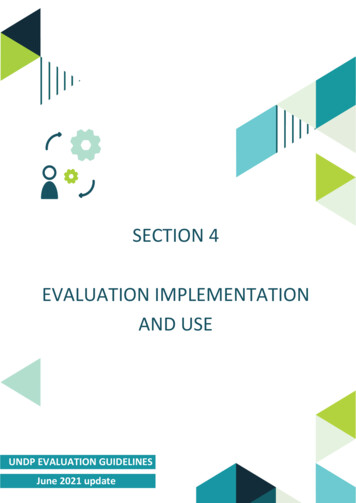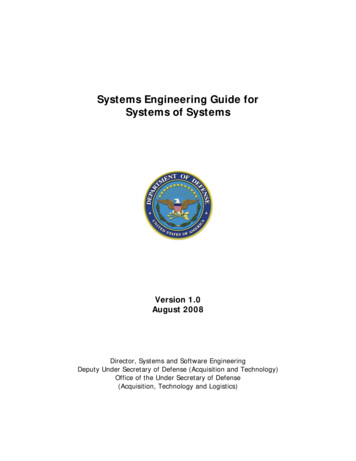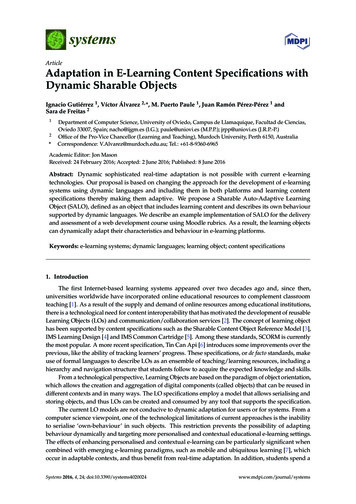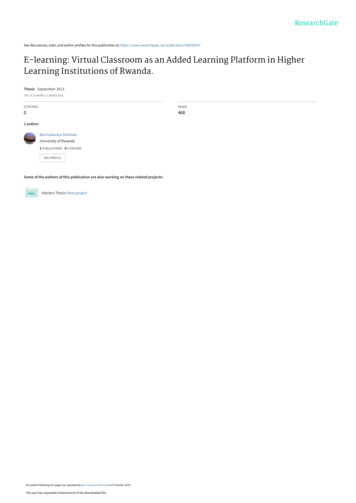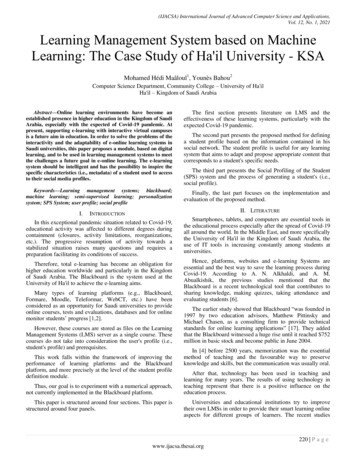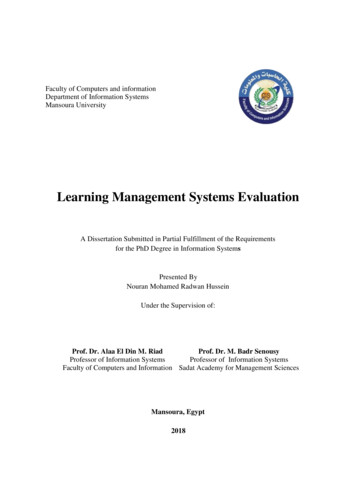
Transcription
Faculty of Computers and informationDepartment of Information SystemsMansoura UniversityLearning Management Systems EvaluationA Dissertation Submitted in Partial Fulfillment of the Requirementsfor the PhD Degree in Information SystemsPresented ByNouran Mohamed Radwan HusseinUnder the Supervision of:Prof. Dr. Alaa El Din M. RiadProf. Dr. M. Badr SenousyProfessor of Information SystemsProfessor of Information SystemsFaculty of Computers and Information Sadat Academy for Management SciencesMansoura, Egypt2018
But those who had been given knowledge said, "Woe toyou! The reward of Allah is better for he who believesand does righteousness. And none are granted it exceptthe patient."Surah Al-Qasas [80]i
DedicationThis dissertation is dedicated to:Allah my creator, my strong pillar and my source of understanding.The loving memory of my grandmother.My beloved Parents who never stop giving of themselves in countless ways.My dearest husband, Hussein who leads me through the valley of darknesswith light of hope and support.My beloved brother who stands by me when things look bleak.ii
AcknowledgmentThere are no proper words to convey my deep gratitude and respect for mydissertation and research advisors, Professor Dr. Alaa El Din M. Riad and ProfessorDr. Mohamed Badr Senousy. They have inspired me to become an independentresearcher and helped me to realize the power of critical reasoning. Their guidancehelped me in all the time of research and writing of this dissertation. Also, ProfessorDr. Mohamed Badr Senousy provided me constructive criticism which helped medevelop a broader perspective to my dissertation.Also, my sincere thanks must go to the members of my dissertation advisory andexam committee: Professor Dr. Ibrahim M. El-Henawy, and Professor Dr. AtefGhalwash. They generously gave their time to offer me valuable comments towardimproving my work.I am most grateful to Professor Dr. Florentin Smarandache [Department ofMathematics, University of New Mexico, USA] and Professor Dr. Ahmed Salama[Department of Mathematics and Computer Science, Faculty of Sciences, Port SaidUniversity, Egypt] for lending me their expertise and helping me to understandneutrosophic approach.There is no way to express sincerely thank to the experts:Alberto Caballero [Associate professor, Computer Science,Universidad Católica SanAntonio de Murcia, Spain ], Vjekoslav Hlede [Senior Learning Management SystemSpecialist, PhD candidate, American Association of Anesthesiologists], StylianosSergis [M.Sc. in "Informatics in Education", PhD candidate, University of Piraeus,Greece], Krzysztof Nesterowicz [E‐Learning specialist, PhD candidate, NationalUniversity of Public Service, Budapest, Hungary], Mugenyi Justice Kintu [PhDResearcher at Vrije Universiteit Brussel, Dept. of Educational Sciences], David Cook[Lecturer in the School of Science and a member of the ECU Security ResearchInstitute], Alex Salas [Learning Management Systsems Admin], and Tarik A. Rashid[Associate Professor on Salahaddin University, Kardistan] for giving their knowledgeto the researcher. Without they precious support it would not be possible to conductthis research.iii
Published Work1. Radwan, Nouran, M. Badr Senousy, and Alaa El Din M. Riad."Approaches for Managing Uncertainty in Learning ManagementSystems." Egyptian Computer Science Journal 40.2 (2016): 1-72. Radwan, Nouran, M. Badr Senousy, and Alaa El Din M. Riad."Neutrosophic Logic Approach for Evaluating Learning ManagementSystems." Neutrosophic Sets and Systems 11(2016):3-7.3. Radwan, Nouran, M. Badr Senousy, and Alaa El Din M. Riad. "A newexpert system for learning management systems evaluation based onneutrosophic sets." Expert Systems 33.6 (2016): 548-558.Indexed in ISI/Thomson Reuters, Impact Factor: 1.184. Radwan, Nouran, M. Badr Senousy, and Alaa El Din M. Riad."Neutrosophic AHP Multi Criteria Decision Making Method Applied onthe Selection of Learning Management System." International Journal ofAdvancements in Computing Technology 8.5 (2016): 95-105.Indexed in SJR, Impact Factor: 0.1155. Radwan, Nouran, M. Badr Senousy, and Alaa El Din M. Riad." A NovelModel for Measuring Learning Management Systems Success." (2016)(Under Review)iv
DeclarationI declare that this dissertation was composed by myself, that the workcontained herein is my own except where explicitly stated otherwise in thetext, and that this work has not been submitted for any other degree orprofessional qualification except as specified.Nouran Mohamed Radwan Husseinv
AbstractEvaluation process studies concern gathering information that assist indecision making about a specific situation concerning measurement,selection, and assessment process. In measurement process, the preferencesthat influence the situation to establish standard rules are determined. Theselection process concerns the selection of the most proper option bycollecting decision makers’ knowledge. Finally, Assessment process gathersimplicit and explicit information to ensure that defined objective has beenattained.Learning management systems (LMSs) are software tools used to assist inthe designing, delivery, and management of learning materials for learners.Therefore, LMSs evaluation process becomes important requirement ineducational institution. LMSs evaluation previous studies are implementedunder complete information, while many uncertainty aspects do exist in thereal world. As LMSs systems were described by decision makers and expertswith vague, imprecise, ambiguous, and inconsistent terms, it iscomprehensible that traditional methods may not be effective.In this dissertation, LMSs evaluation model is presented which concernsthree challenges: exploring the factors affects the success of LMS, seeking todetermine the most suitable alternative that meets institution’s requirements,and assessing the LMS quality.Due to the first challenge, as success is not measurable with a single factorsuch as intention of use or user satisfaction, several researches have beenidentified different factors for the success of information systems andeLearning systems. In this side of study, an investigation of the LMSssuccess critical factors from different perspectives and development of acomprehensive model for measuring success of LMSs based on previousresearches and experts in the context of eLearning practices in highereducation based on neutrosophic sets are presented based on neutrosophicvi
logic as a better option to simulate human thinking to address indeterminacyof information. The findings show that learner characteristics, informationquality and service quality factors have the most important concern on LMSssuccess studies.Due to the second challenge, this part of study develops a novel hybridneutrosophic analytic hierarchy process method to support handlinguncertainty in the decision-making process to address indeterminacy ofinformation. To show the applying of the developed method, a numericalexample of an LMS selection is made using the method of neutrosophicanalytic hierarchy process. In results, it is shown that the neutrosophic logiccan represent uncertainty manner by human thinking. Obtained results haveshown that Moodle is the most suitable LMS that meets defined criteria.Due to the third challenge, this portion of dissertation presents neutrosophicexpert system for learning management systems quality assessment. Asneutrosophic logic is an approach to simulate human reasoning as it canhandle indeterminacy of information which indicates the percentage ofanonymous parameters. Building and validating information of theneutrosophic expert system are collected from eight experts using semistructured questionnaire, and then analysis is done. Finally, the comparisonbetween fuzzy expert system and neutrosophic expert system results showthat the neutrosophic logic is capable of representing uncertainty in humanthinking for evaluating LMSs.vii
Table of ContentsChapter 1: Introduction .21.1 Motivations . 21.2 Problem Statement . 21.3 Objectives . 31.4 Dissertation Contribution . 31.5 Dissertation Outline . 4Chapter 2: Background and Related Work . 62.1 Introduction. 62.2 Learning Management Systems . 82.3 Evaluation Methods for Learning Management Systems . 82.4 Multivalued Logic Models for handling Uncertainty . 112.4.1 Uncertainty Types . 112.4.2 Fuzzy Set . 122.4.3 Type 2 Fuzzy Set . 132.4.4 Intuitionistic Fuzzy Set . 142.4.5 Neutrosophic Logic . 152.5 Uncertainty and Multivalued Logic Models . 162.6 Learning Management Systems Evaluation . 172.6.1 Learning Management Systems Success . 182.6.2 Learning Management Systems Selection . 192.6.3 Learning Management Systems Quality Assessment . 202.7 Summary . 22Chapter 3: Learning Management Systems Success Measurement Model . 253.1 Learning Management Systems Success .253.2 Learning Management Systems Success Critical Factors. 263.3 Learning Management Systems Success Models . 283.4 The Proposed Learning Management Systems Success Measurement Model . 313.5 Summary . 40Chapter 4: Learning Management Systems Selection . 42viii
4.1 Learning Management Systems Selection . 424.2 Analytical Hierarchy Process . 434.3 Some Concepts of Neutrosophic Set . 454.4 Neutrosophic Analytical Hierarchy Process (NAHP) for Learning Management Selection 464.5 Summary . 59Chapter 5: Learning Management Systems Quality Assessment . 615.1 Learning Management Systems Quality . 615.1.1 Usability . 625.1.2 Reliability . 635.1.3 Accessibility . 635.2 Neutrosophic Expert System . 645.3 Neutrosophic Expert System for LMSs Quality Assessment . 665.3.1 Neutrosophic Expert System Algorithm . 675.3.2 Membership Functions for Input Parameters . 675.3.3 Knowledgebase and Evaluation Process. 695.3.4 Membership and Knowledge Base for Output . 725.3.5 Validating Neutrosophic Expert System. 735.4 Neutrosophic Expert System . 745.5 Summary . 75Chapter 6: Results and Discussion . 776.1 Introduction. 776.2 Learning Management Systems Success . 786.3 Learning Management Systems Selection . 796.4 Learning Management Systems Quality Assessment . 81Chapter 7: Conclusion and Future Work . 847.1 Conclusion . 847.2 Future Work . 85References . 87ix
List of Tables2.1 Multivalued Logic Models and Uncertainty Data Types3.1 Success Factors and References3.2 Factor Importance3.3 Weight importance between factors4.1 Linguistic variables and Importance weight based on neutrosophic values4.2 Pairwise Comparison Matrix with Respect to the Goal4.3 Consistency Pairwise Comparison Matrix with Respect to the Goal4.4 Pairwise Comparison Matrix for the Sub Criteria Under Evaluative Tools4.5 Pairwise Comparison Matrix for the Sub Criteria Under Compatibility4.6 Pairwise Comparison Matrix for the Sub-criteria under Support4.7 The Overall Priority of the Criteria and the Sub Criteria4.8 Pairwise Comparison Matrix for the Alternatives Under Cost4.9 Pairwise Comparison Matrix for the Alternatives Under Student Tracking4.10 Pairwise Comparison Matrix for the Alternatives Under Exam Pool4.11 Pairwise Comparison Matrix for the Alternatives Under Platform4.12 Pairwise Comparison Matrix for the Alternatives Under Content Developing Tools4.13 Pairwise Comparison Matrix for the Alternatives Under Documentation4.14 Pairwise Comparison Matrix for the Alternatives Under Technical4.15 Pairwise Comparison Matrix for the Alternatives Under Sustainability4.16 The Overall Score of Different 658
List of Figures2.1 Multivalued Logic Models and Uncertainty Data Types2.2 Block Diagram of Fuzzy Inference System2.3 Type 2 Fuzzy Set2.4 Block Diagram of Type 2 Fuzzy Inference System2.5 Intuitionistic Fuzzy Set2.6 Block Diagram of Intuitionistic Fuzzy Inference System2.7 Neutrosophic Set2.8 Block Diagram of Neutrosophic Inference System3.1 Factors Affecting LMSs success3.2 DeLone and McLean Success Model3.3 Holsapple and Lee-Post Success Model3.4 Sun et al. Success Model3.5 LMSs Success Proposed Model4.1 Analytical Hierarchy Process4.2 Decision Hierarchy Model of LMS5.1 Fuzzy and Neutrosophic Membership functions of inputs5.2 The Difference between Fuzzy Expert System and Neutrosophic Expert System5.3 Neutrosophic Expert System Steps5.4 LMSs System Quality of Neutrosophic Expert System5.5 Efficiency True Input Membership5.6 Efficiency Indeterminacy Input Membership5.7 Efficiency False Input Membership5.8 True Usability Knowledge Base5.9 Indeterminacy Usability Knowledge Base5.10 False Usability Knowledge Base5.11 True System Quality Knowledge Base5.12 Indeterminacy System Quality Knowledge Base5.13 False system quality Knowledge Base5.14 System Quality True Membership5.15 System Quality Indeterminacy Membership5.16 System Quality False Membership5.17 Knauf Validation Framework6.1 Evaluation Proposed Model6.2 Results of the Factor Importance by Fuzzy Set and Neutrosophic Set6.3 Weight Percentages presented in Neutrosophic values6.4 Weight Percentages presented in Deneutrosophied values6.5 Weight Percentages of the Neutrosophic Scale Based the Alternatives6.6 Weight Percentages of the Deneutrosophied values of Alternatives6.7 Results of the applied examples of Fuzzy and Neutrosophic Expert 697070707171717272737476777879808082
List of AbbreviationsAHPANPCRLMSMCDMNAHPTAMAnalytical Hierarchy ProcessAnalytical Network ProcessConsistency RatioLearning Management SystemMulti-Criteria Decision MakingNeutrosophic Analytical Hierarchy ProcessTechnology Acceptance Modelxii
Chapter 1Introduction1
Chapter 1: Introduction1.1 MotivationsMost of the Learning Management Systems (LMSs) are web based applicationsthat are being used to in designing, sharing, delivering, and managing learningmaterials. There has been a rapid raise in applying LMSs in higher education asmany universities recognize the importance of LMSs to raise motivation oflearners. Therefore, LMSs evaluation process becomes significant requirementin higher education institution. The LMSs evaluation is a decision-makingprocess including LMSs success achievement, LMSs selection procedure andLMSs assessment method.1.2 Problem StatementMany Universities recognize the necessity of using Learning ManagementSystems (LMSs) to increase motivation of learners and provide support duringthe learning process. Previous studies in LMSs evaluation are implementedunder the condition of full information availability, while many uncertaintyaspects do exist in the real world. As LMSs are described by decision makersand experts with vague, imprecise, ambiguous, and inconsistent terms; thereforethe traditional methods may not be effective. LMSs evaluation process seeks toidentify the critical factors that affect LMSs success measurement, select themost suitable LMS option due to organization requirements, and assess LMSssystem quality.LMSs evaluation process includes LMSs success measurement, LMSs selectionand LMSs quality assessment. Evaluation process collects information andknowledge that help in making a decision about a given situation regarding theappropriateness of something. Measurement process includes determiningattributes or preferences that affect the objective to some establish rule.Selection process includes choosing the most suitable option by collectingavailable information. Assessment process collects implicit or explicitinformation relative to well-known goal.2
1.3 ObjectivesThe Dissertation concerns LMSs evaluation process to help educationalinstitutions to achieve the success of LMSs, select the most suitable LMSsaccording to requirements and assess LMSs quality. These can be expressed inthe following lines: Exploring critical factors that affect the success of LMSs implementation. Developing a comprehensive model for LMSs success measurement. Developing and applying an intelligent decision making method for LMSsselection. Identifying the most important system quality dimensions which isvaluable to learners. Developing an expert system for assessing LMSs Quality. 1.4 Dissertation ContributionLMS evaluation process becomes a significant task in educational organizationsdue to the raising number of LMSs software usage. LMSs evaluation task inprevious studies is performed under condition of the availability of fullinformation. Real environment is characterized by vague, imprecise, ambiguityand inconsistency data and information. The dissertation concerns LMSsevaluation process under uncertainty which includes three procedures:presenting LMSs success measurement model, developing LMSs selectionmethod that meets organization’s requirements, and building system for LMSsquality.In this dissertation, LMSs evaluation is a process concerns three procedures:First, the dissertation presents the critical factors that affect LMSs success and asurvey for LMSs success models survey presented previously. The studypresents an overall model for LMSs success measurement that shows therelationships among the constructs of the model.3
Second, the study develops a novel multi-criteria decision making method forLMSs selection. One of the most multi-criteria decision making method is AHPwhich deals with quantitative and qualitative attributes using hierarchicalstructure. The major AHP deficiency is its weakness of representing human’suncertain thoughts, thus the study extends the AHP method via the neutrosophicset to express human's preferences. The presented method provides reliableresults by expressing uncertain and checking inconsistency during the pairwisecomparisons.Third, the dissertation presents a neutrosophic expert system for LMSs qualityassessment that takes in account uncertainty that is a feature of real environment.The neutrosophic logic is capable of expressing uncertainty in human thinkingfor assessing LMSs. The system simulation has been carried out by Fuzzytech5.54 application by building three fuzzy inference systems representing the true,indeterminate, and false value. While the information needed for building andvalidating the system is collected by eight experts’ semi-structuredquestionnaires.1.5 Dissertation OutlineThe dissertation is organized into seven chapters as follows:Chapter 2 presents different multivalued logic models that handle uncertaintyand gives a hint about dissertation challenges. Chapter 3 presents an illustrationfor the critical factors of LMSs success and introduces LMSs successmeasurement model. Chapter 4 presents a neutrosophic analytical hierarchyprocess method as a novel approach for decision making for LMSs selection. InChapter 5, neutrosophic expert system for LMSs quality assessment ispresented. Chapter 6 includes the dissertation discussion and results; Chapter 7includes conclusion and future work.4
Chapter 2Background andRelated Work5
Chapter 2: Background and Related Work2.1 IntroductionLearning Management Systems (LMSs) are software applications used to help inthe designing, sharing, delivery, management, and assessment of learningresources to all learners [1]. A sudden increase of the LMSs usage in highereducation is observed [2]. With the ever-growing number of LMSs, educationalinstitutions try seriously to determine which LMS able to achieve success fortheir case [3]. There is a need to assist educational universities withcomprehensive model for LMSs evaluation [4]. LMSs evaluation process seeksto identify the critical factors that affect LMSs success, determine the mostappropriate LMS software from a set of options due to organizationrequirements, and assess LMSs system quality [5].Previous studies have used information system success models in the learningfield, but many researchers express their need to propose an IS success modelfor e- learning purposes and especially for LMS. In [6] system quality, servicequality, information quality, learner perspective, instructor attitudes, andsupportive issues had a considerable effect on the learner’s perceivedsatisfaction. Results of [7] reveals six factors including user characteristics,extrinsic motivation, service quality, system quality, and information quality thatinfluence the acceptance of eLearning systems in developing countries.Perceived ease of use, user satisfaction, learner characteristics, instructor, LMScharacteristics and organization characteristics have influence on LMSs success[8]. System quality is very important factor in relation to the service quality,information quality and learning community [9] [10]. The success of LMSs inhigher education institutions initiated by instructors; however, the use of LMSsis sustained by learners. Therefore, the need for exploring the critical factors anddeveloping a comprehensive model that measure the success of LMS fromdifferent perspectives is emerged [9].6
There is much software of LMSs available in marketplace; this makeseducational institutions attempt industriously to determine which LMS is themost appropriate for their needs [3]. The most suitable LMS selection that meetsthe organization needs is a decision making problem [11]. One of the approachesof decision making is multi-criteria decision making methods which help intaking decisions including many criteria contains functional and non-functionalrequirements [5]. Decision process could correspond to choose the mostalternative or ranking a set of good alternatives by analyzing different criteria[12]. Previous studies in LMSs selection are implemented using traditional multicriteria decision making methods that may not be effective as these systemswere described by decision makers with uncertainty terms [13].There has been a sudden increase in the usage of LMSs applications to supportlearner's learning process in higher education. Many studies in LMS assessmentare implemented under the assumption of full information availability, while thereal world has uncertainty sides [14]. Previous evaluation models for eLearningquality attributes developed under full information availability condition.Imprecise knowledge, incomplete information and uncertain data arecharacteristics of real environment; this leads researchers to turns into otherapproaches that handle uncertainty like fuzzy logic [15, 16] and to suggestneutrosophic logic that handle uncertainty for eLearning quality evaluation [17].Expert system simulates human expert thinking to solve problem and takedecision domain which is mainly composed of the user interface, knowledgebase, and inference engine [18]. Expert system aims to represent the problem ofuncertainty in knowledge to draw conclusion with the same level of accuracy aswould a human expert do [19]. Designing an expert system depends onpersonnel interaction; expert who has knowledge and solves the problems,knowledge engineer who encodes the expert’s knowledge in inference engineand knowledge base; user who uses the system to get advice and informationneeded [18, 20].7
2.2 Learning Management SystemsLearning Management Systems (LMSs) are web based applications used todayin eLearning that supports teaching and learning activities associated with them[2]. LMSs are gaining interest as a management and communication tools forinstructors, learners and trainers. LMSs are information systems that assist indesigning, sharing, delivering, managing and evaluating of educational resourcesto all learners [1]. LMSs provide universities with a set of tools such asdiscussion forums, chats, automated testing, assessing tools and student tracking.The LMSs provide instructors and learners with a user-friendly, and acomprehensive interactive interface for managing course catalogues, recordingdata and providing reports [21].Management information systems are computer based systems that providemanagers with tools help in managing departments and taking better decisions.This includes transaction processing system, decision support system, expertsystem, or executive information system. LMS are information systems thatsupport management and communication associated with learning process [22,23]. Management information systems development needs to visualize thecomplete functionality of the system. As LMS software is suitable andsuccessful in one education institution, it does not mean that will be successfulfor other institutions [24]. There could be more studies needed in differentaspects like extra modules for indicating the best content of similar subjects,transmission any information from the participating universities, and checkingthe quality of the content [2].2.3 Evaluation Methods for Learning Management SystemsSoftware evaluation is a process that seeks to determine if software is the mostsuitable from a set of alternatives due to institution functional and nonfunctional requirements. A prepared list of software criteria is helpful todetermine if the software would be suitable to the user or not. Evaluationprocess includes decision making process that is needed to select the mostconvenient LMS option from available possibilities due to organization needsand requirements [5]. Taking a decision could correspond to select the fit8
alternative from a set of alternatives or to choose a small group of most suitablealternatives by analyzing different criteria [12].Evaluation process concerns collecting information that help in decision makingabout a given state regarding measurement, selection, and assessment process.Measurement process determines attributes or preferences that affect the state tosome establish rules or standard. Selection process includes choosing the mostsuitable option by obtaining knowledge from decision makers. Assessmentproces
A Dissertation Submitted in Partial Fulfillment of the Requirements for the PhD Degree in Information Systems . Learning management systems (LMSs) are software tools used to assist in the designing, delivery, and management of learning materials for learners. . 4.4 Pairwise Comparison Matrix for the Sub Criteria Under Evaluative Tools 51 4. .



